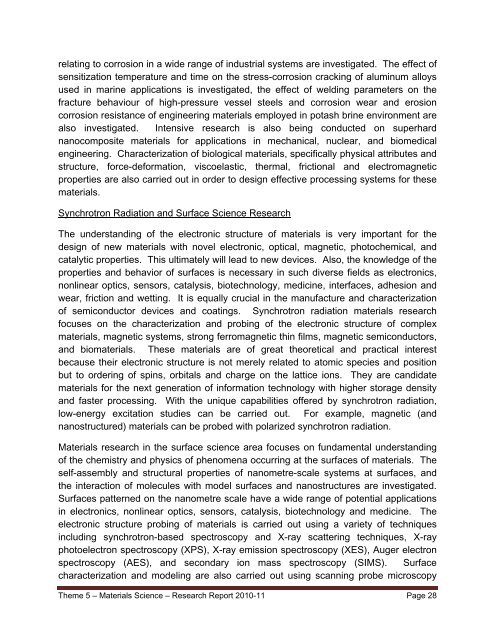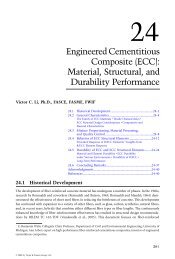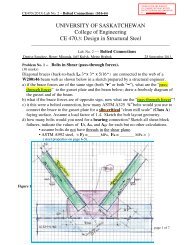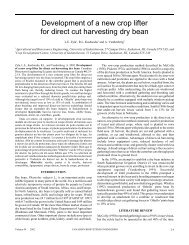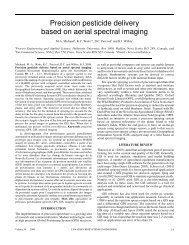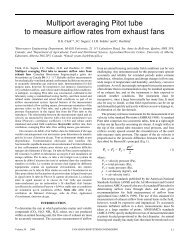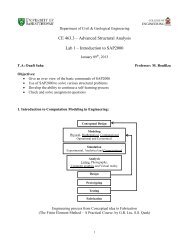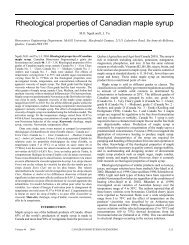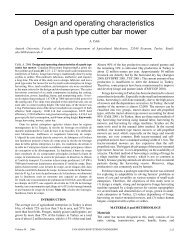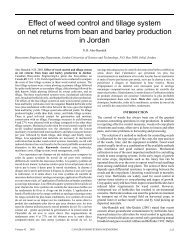Research Report 2010-2011 - College of Engineering - University of ...
Research Report 2010-2011 - College of Engineering - University of ...
Research Report 2010-2011 - College of Engineering - University of ...
You also want an ePaper? Increase the reach of your titles
YUMPU automatically turns print PDFs into web optimized ePapers that Google loves.
elating to corrosion in a wide range <strong>of</strong> industrial systems are investigated. The effect <strong>of</strong><br />
sensitization temperature and time on the stress-corrosion cracking <strong>of</strong> aluminum alloys<br />
used in marine applications is investigated, the effect <strong>of</strong> welding parameters on the<br />
fracture behaviour <strong>of</strong> high-pressure vessel steels and corrosion wear and erosion<br />
corrosion resistance <strong>of</strong> engineering materials employed in potash brine environment are<br />
also investigated. Intensive research is also being conducted on superhard<br />
nanocomposite materials for applications in mechanical, nuclear, and biomedical<br />
engineering. Characterization <strong>of</strong> biological materials, specifically physical attributes and<br />
structure, force-deformation, viscoelastic, thermal, frictional and electromagnetic<br />
properties are also carried out in order to design effective processing systems for these<br />
materials.<br />
Synchrotron Radiation and Surface Science <strong>Research</strong><br />
The understanding <strong>of</strong> the electronic structure <strong>of</strong> materials is very important for the<br />
design <strong>of</strong> new materials with novel electronic, optical, magnetic, photochemical, and<br />
catalytic properties. This ultimately will lead to new devices. Also, the knowledge <strong>of</strong> the<br />
properties and behavior <strong>of</strong> surfaces is necessary in such diverse fields as electronics,<br />
nonlinear optics, sensors, catalysis, biotechnology, medicine, interfaces, adhesion and<br />
wear, friction and wetting. It is equally crucial in the manufacture and characterization<br />
<strong>of</strong> semiconductor devices and coatings. Synchrotron radiation materials research<br />
focuses on the characterization and probing <strong>of</strong> the electronic structure <strong>of</strong> complex<br />
materials, magnetic systems, strong ferromagnetic thin films, magnetic semiconductors,<br />
and biomaterials. These materials are <strong>of</strong> great theoretical and practical interest<br />
because their electronic structure is not merely related to atomic species and position<br />
but to ordering <strong>of</strong> spins, orbitals and charge on the lattice ions. They are candidate<br />
materials for the next generation <strong>of</strong> information technology with higher storage density<br />
and faster processing. With the unique capabilities <strong>of</strong>fered by synchrotron radiation,<br />
low-energy excitation studies can be carried out. For example, magnetic (and<br />
nanostructured) materials can be probed with polarized synchrotron radiation.<br />
Materials research in the surface science area focuses on fundamental understanding<br />
<strong>of</strong> the chemistry and physics <strong>of</strong> phenomena occurring at the surfaces <strong>of</strong> materials. The<br />
self-assembly and structural properties <strong>of</strong> nanometre-scale systems at surfaces, and<br />
the interaction <strong>of</strong> molecules with model surfaces and nanostructures are investigated.<br />
Surfaces patterned on the nanometre scale have a wide range <strong>of</strong> potential applications<br />
in electronics, nonlinear optics, sensors, catalysis, biotechnology and medicine. The<br />
electronic structure probing <strong>of</strong> materials is carried out using a variety <strong>of</strong> techniques<br />
including synchrotron-based spectroscopy and X-ray scattering techniques, X-ray<br />
photoelectron spectroscopy (XPS), X-ray emission spectroscopy (XES), Auger electron<br />
spectroscopy (AES), and secondary ion mass spectroscopy (SIMS). Surface<br />
characterization and modeling are also carried out using scanning probe microscopy<br />
Theme 5 – Materials Science – <strong>Research</strong> <strong>Report</strong> <strong>2010</strong>-11 Page 28


